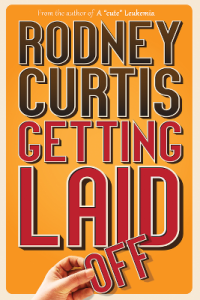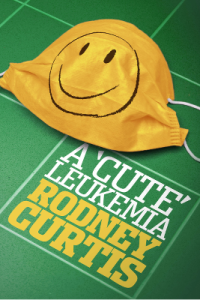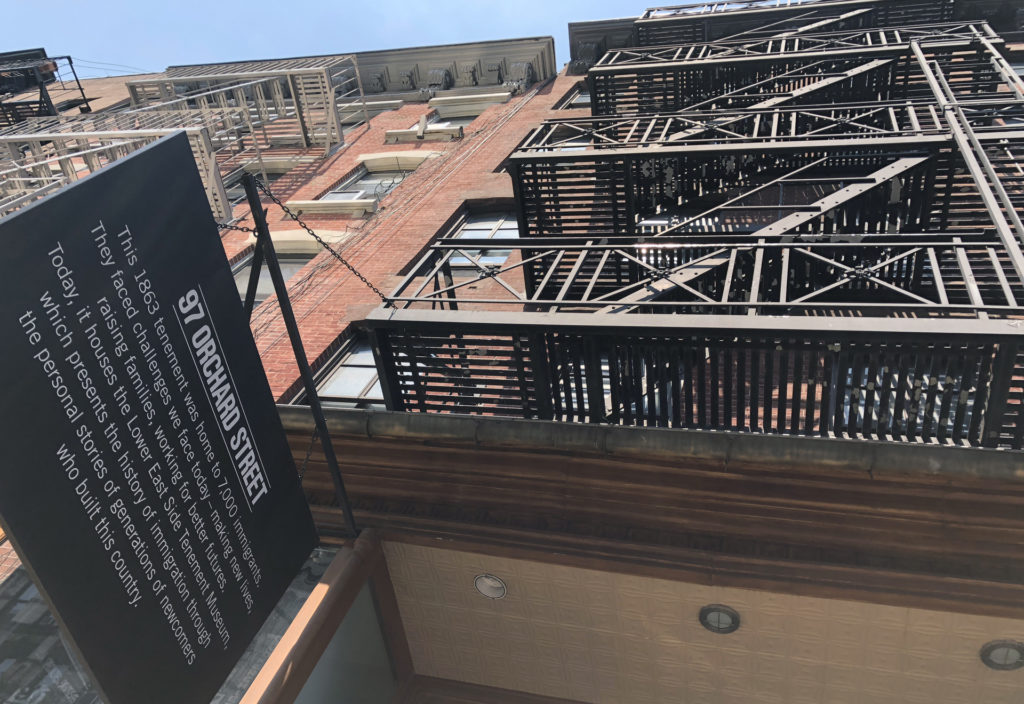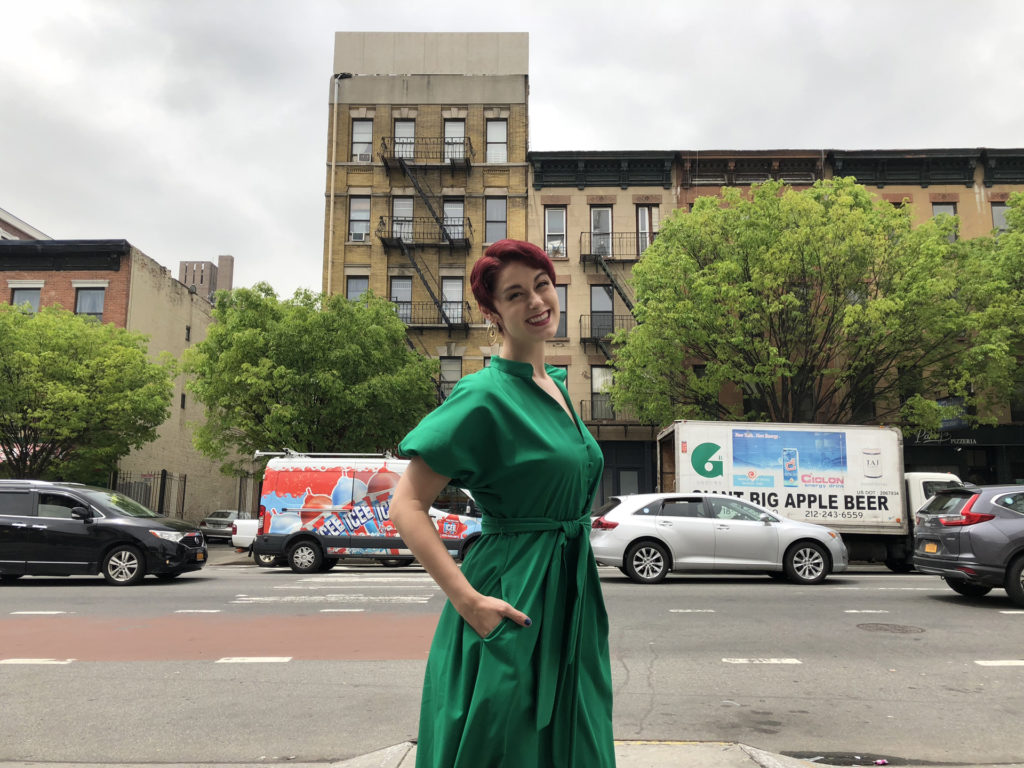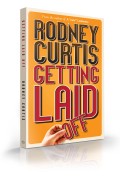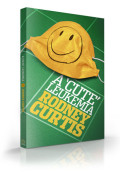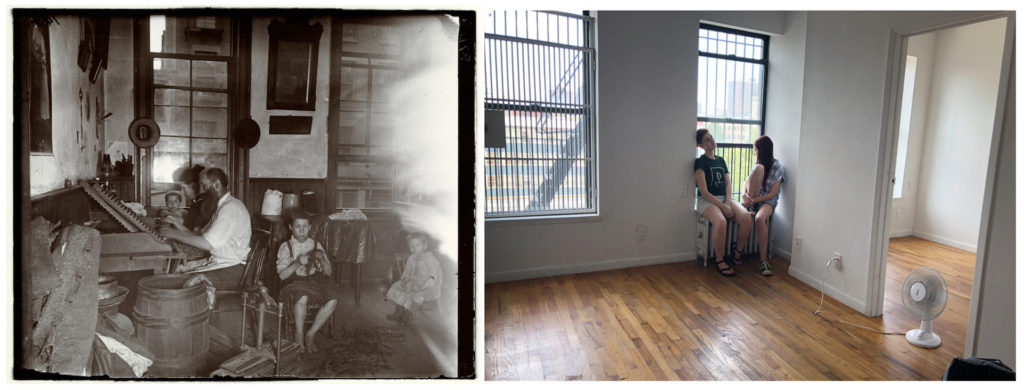
It’s a far cry from THEN to NOW in New York City apartments. The photo at left of tenement life is by Jacob Riis. The photo at right of my daughter and roommate is by me.
I think it was somewhere during my sixth or seventh trip up or down my daughter’s East Harlem apartment stairs that I realized just how lucky we are, how good we have it. Living on the fifth floor of an old building with terrible heat and no air conditioning, my daughter attended grad school at Columbia for two years.
The lack of heat wasn’t an issue as we moved her, though; outside it was 91 degrees. Inside it felt even hotter. But I can’t believe how fortunate we were, we are.
She and her roommate paid a couple grand per month for the opportunity to live there. By modern standards it was cramped, had no elevator, dishwasher, laundry and at some point last summer, a rock came crashing through their window (I mentioned they lived on the fifth floor, right?)
She and her roommate did have a sink, a flush toilet, a tub & shower, a fridge. This wasn’t the 19-teens after all.
100 years ago, the 19-teens, New York City had vastly different living conditions. I know this because I finally had the opportunity to tour the famous Tenement Museum on the Lower East Side. The museum froze in time what immigrants to America had to endure. It was enlightening, visiting the old tenements just before helping move my daughter. Such a great contrast.
Tiny, dark, cramped apartment buildings housed throngs of people without even indoor sinks or toilets at first. Everyone was crammed together.
A young girl moved into one of the tenement apartments way back then. She came back as an old woman and recorded her remembrances of the place. Her mother would stand half-naked at the sink, washing; father would always have the radio on and tuned to an Italian broadcast; she and her sibling shared the tiniest of rooms. They were mostly pleasant memories for her.
My daughter also has pleasant memories of her stay, “It was near Costco,” she smiled.
People who arrived at Ellis Island obviously didn’t have big box stores back then. They shopped from neighborhood street stalls and small, ground-floor shops in the tenement buildings. Different ethnicities generally sorted themselves into neighborhoods, but Italians or Jews might have lived with Germans or Asians. So there was an enormous mixing of cultures, a bubbling melting pot.
Squalor and disease were rampant, though. Reforms began, due in part to wealthy Upper East Siders being afraid of cholera spreading or other diseases or crimes invading their neighborhoods. The Roosevelts — Teddy first, then Franklin Delano — helped crusade for change. Journalists got in on the act too, as did at least one photographer, Jacob Riis, who published a book about the conditions affecting families trying to eke out a living in the city. Teddy Roosevelt called him “New York’s most useful citizen,” for his late 1800’s dismal portrayal of life inside tenements.
I feel for our immigrant ancestors. Even though my mother was born in 1930s New York City, her upbringing was vastly different than the young girl from the tenement. Mom was lucky; she was born into comfortable, if not wealthy, surroundings. My daughter was lucky, also being born into a comfortable Middle Class family. I had a leg-up; she had a leg-up; we all had a leg-up and it began way before any of us were born.
That’s the thing that gets me. It got to me too as I was trudging up and down that cramped stairwell. Simply by the random act of where we are born — into what family, what tribe, what city, what country — our paths are paved.
I felt a kind of down-through-the-ages feeling. My mother living in and around New York in the 1930s and 40s — my daughter living there now. The similarities and differences bounced back and forth. Did my mother ever try Patsy’s Pizzeria, founded the year she was born and still in the same shop my daughter lived above? How many theaters did Skye and my mother both sit in, separated by 60 years?
Instead of wondering, I had the luxury of asking Mom about the city way back then. She didn’t remember Patsy’s Pizza, but she recalled passing through Harlem and being fascinated by the folks hanging their wash out of their windows and being all crowded in together.
She was born in the city proper and then lived just outside. “I wasn’t even aware of the tenements on the Lower East Side when we lived in the suburbs,” she explained. But even so, her father’s mom and dad lived in the same home with them — her, her twin sister, her mother and father, like many of the immigrant families did.
Decidedly, her life was vastly different. “We would go down to Wall Street to have a fancy lunch with my father,” Mom told me. “We loved the Horn and Hardart automat. You’d walk in and see a wall of little glass doors.” Pre-prepared food sat in little slots. “You could put your money in and get your lunch. Our favorites were Salisbury steak and creamed spinach.”
These days, one of my daughter’s favorite restaurants was a nearby Mexican joint with great rice and beans. “Whenever we were in the city,” my mother said, “we’d eat at Chock full o’ Nuts and have cream cheese sandwiches on raisin bread.” Apparently it was very popular. “Their signature “nutted cheese” sandwich, made of cream cheese and chopped nuts on dark raisin bread, cost a nickel with a cup of coffee when the company was founded,” also right around when my mother was born, says Wikipedia.
I love hearing about the divergences, between my mother, my daughter, our forebears. Without knowing from whence we came, it may have been easier to grouse about climbing all those steps to my daughter’s sweltering apartment.
They’ve left the city now; the early immigrants, my mother, my daughter. But like the tenants lined up to take Skye’s apartment — moving in just after we moved out — new groups move in, making new lives and memories. Roughly three million immigrants now call New York City home. Folks from the Dominican Republic, China and Mexico comprise some of the biggest groups, as do Jamaicans, Guyanese, Ecuadoreans and many other diverse and wonderful groups.
The circle continues, hopefully forever.
FOOTNOTE: It wasn’t until the Immigration Act of 1924 that people arriving to this country first needed visas to enter. Then quotas from different regions of the world went into effect. Most all Asians were excluded from immigrating here for quite some time. (Thank goodness, as a country, we’ve gotten over excluding entire populations of people based on artificial, surface-level things — bitter sarcasm intended).
